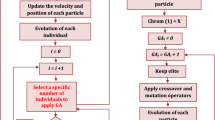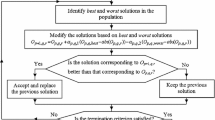Abstract
Submerged arc welding (SAW) is characterized as a multi-input process. Selection of optimum combination of process parameters of SAW process is a vital task in order to achieve high quality of weld and productivity. The objective of this work is to optimize the SAW process parameters using a simple optimization algorithm, which is fast, robust and convenient. Therefore, in this work a very recently proposed optimization algorithm named Jaya algorithm is applied to solve the optimization problems in SAW process. In addition, a modified version of Jaya algorithm with oppositional based learning, named “Quasi-oppositional based Jaya algorithm” (QO-Jaya) is proposed in order to improve the performance of the Jaya algorithm. Three optimization case studies are considered and the results obtained by Jaya algorithm and QO-Jaya algorithm are compared with the results obtained by well-known optimization algorithms such as Genetic algorithm (GA), Particle swarm optimization (PSO), Imperialist competitive algorithm (ICA) and Teaching learning based optimization (TLBO).
Similar content being viewed by others
References
K. Y. Benyounis and A. G. Olabi, Optimization of different welding processes using statistical and numerical approaches -A reference guide, Advances in Engineering Software, 39 (2008) 483–196.
S. Datta, A. Bandyopadhyay and P. K. Pal, Application of PCA-based hybrid Taguchi method for correlated multicriteria optimization of submerged arc weld: a case study, International Journal of Advanced Manufacturing Technology, 45 (2009) 276–286.
D. V. Kiran, B. Basu, A. K. Shah, S. Mishra and A. De, Probing influence of welding current on weld quality in two wire tandem submerged arc welding of HSLA steel, Science and Technology of Welding and Joining, 15 (2) (2010) 111–116.
J. E. R. Dhas and S. Kumanan, Optimization of parameters of submerged arc weld using non-conventional techniques, Applied Soft Computing, 11 (2011) 5198–5204.
H. K. Narang, M. M. Mahapatra, P. K. Jha and I. Mukherjee, Modelling and predicting the effects of submerged arc weldment process parameters on weldment characteristics and shape profiles, Journal of Engineering Manufacture, 226 (7) (2012) 1230–1240.
D. V. Kiran, B. Basu and A. De, Influence of process variables on weld bead quality in two wire tandem submerged arc welding of HSLA steel, Journal of Materials Processing Technology, 212 (2012) 2041–2050.
L. Lan, C. Qiu, D. Zhao, X. Gao and L. Du, Analysis of microstructural variation and mechanical behaviors in submerged arc welded joint of high strength low carbon bainitic steel, Materials Science & Engineering A, 558 (2012) 592–601.
P. Li and H. Lu, Hybrid heat source model designing and parameter prediction on tandem submerged arc welding, International Journal of Advanced Manufacturing Technology, 62 (2012) 577–585.
J. Lee and C. Y. Song, Estimation of submerged-arc welding design parameters using Taguchi method and fuzzy logic, Journal of Engineering Manufacture, 227 (4) (2013) 532–542.
R. V. Rao and V. D. Kalyankar, Experimental investigation on submerged arc welding of Cr-Mo-V steel, International Journal of Advanced Manufacturing Technology, 69 (2013) 93–106.
J. Roy, A. Majumder, S. C. Saha and R. N. Rai, Optimization of the effect of welding heat input on the microstructure and mechanical properties of submerged arc welded joints by fuzzy-based multiobjective threshold acceptance algorithm, Journal of Engineering Manufacture, 227 (12) (2013) 1830–1840.
A. Singh, S. Datta, S. S. Mahapatra, T. Singha and G. Majumdar, Optimization of bead geometry of submerged arc weld using fuzzy based desirability function approach, Journal of Intelligent Manufacturing, 24 (2013) 35–44.
A. Sarkar, A. Majumder, M. Pawar, S. C. Saha and R. N. Rai, Optimization of process parameters of submerged arc welding by using grey-fuzzy-based Taguchi method for AISI 1518 grade steel, Journal of Engineering Manufacture(2013) Doi: 10.1177/0954405414521064.
V. A. Sudnik, V. A. Erofeev, A. V. Maslennikov, D. V. Slezkin and R. V. Tsvelev, A mathematical model of the submerged-arc welding process and phenomena in the arc cavity, Welding International, 65 (7) (2013) 3–12.
M. H. K. Lafdani, E. G. Zahrani and A. M. Galloway, Optimization study of weld geometry in the tandem submerged arc welding process, Journal of Engineering Manufacture(2014) Doi:10.1177/095440541453557.
M. Aghakhani, M. R. Ghaderi, A. Karami and A. A. Derakhshan, Combined effect of TiO2 nanoparticles and input welding parameters on the weld bead penetration in submerged arc welding process using fuzzy logic, International Journal of Advanced Manufacturing Technology, 70 (2014) 63–72.
Y. Lu, J. S. Chen, Y. M. Zhang and L. Kvidahl, Predictive control based double-electrode submerged arc welding for filet joints, Journal of Manufacturing Processes, 16 (2014) 415–426.
D. Podder, N. R. Mandal and S. Das, Heat source modeling and analysis of submerged arc welding, Welding Journal, 93 (2014) 183–192.
M. R. Ghaderi, M. Aghakhani, A. Eslampanah and K. Ghaderi, The application of imperialist competitive algorithm for optimization of deposition rate in submerged arc welding process using TiO2 nano particle, Journal of Mechanical Science and Technology, 29 (1) (2015) 357–364.
M. A. Moradpour, S. H. Hashemi and K. Khalili, Multiobjective optimization of welding parameters in submerged arc welding of API X 65 steel plate, Journal of Iron Steel Research International, 22 (9) (2015) 870–878.
A. Mitra, N. S. Prasad and G. D. J. Ram, Estimation of residual stresses in an 800 mm thick steel submerged arc weldment, Journal of Materials Processing Technology, 229 (2016) 181–190.
M. Kazemi, M. Aghakhani, H. J. Ehsan and A. Behmaneshfar, Optimization of the depth of penetration by welding input parameters in saw process using response surface methodology, Metallurgical Materials Transaction B, 47 (2016) 714–719.
R. V. Rao, Jaya: A simple and new optimization algorithm for solving constrained and unconstrained optimization problems, International Journal of Industrial Engineering Computations, 7 (1) (2016) 19–34.
Y. Zhang, X. Yang, C. Cattani, R. V. Rao, S. Wang and P. Phillips, Tea category identification using a novel fractional fourier entropy and Jaya algorithm, Entropy, 18 (2016) 77.
R. V. Rao, D. P. Rai, J. Ramkumar and J. Balic, A new multiobjective Jaya algorithm for optimization of modern machining processes, Advances in Production Engineering and Management, 11 (4) (2016) 271–286.
Author information
Authors and Affiliations
Corresponding author
Additional information
Recommended by Associate Editor Young Whan Park
Ravipudi Venkata Rao is a Professor in the Department of Mechanical Engineering of S.V. National Institute of Technology, Surat, Gujarat (India). He received his B.Tech. degree from Nagarjuna University, M.Tech. degree from BHU, Varanasi, and Ph.D. degree from BITS, Pilani, India and D.Sc. degree from Poland. He has more than 26 years of teaching and research experience. He has authored more than 300 research papers published in various reputed international journals and conference proceedings. He is also on the editorial boards of various international journals and Associate Editor of few. His research interests include advanced engineering optimization techniques and the applications, advanced manufacturing technology, automation and robotics.
Dhiraj P. Rai is a Research Scholar in the Department of Mechanical Engineering of S.V. National Institute of Technology, Surat, Gujarat (India). His research interests include advanced engineering optimization techniques and their applications in manufacturing.
Rights and permissions
About this article
Cite this article
Rao, R.V., Rai, D.P. Optimization of submerged arc welding process parameters using quasi-oppositional based Jaya algorithm. J Mech Sci Technol 31, 2513–2522 (2017). https://doi.org/10.1007/s12206-017-0449-x
Received:
Revised:
Accepted:
Published:
Issue Date:
DOI: https://doi.org/10.1007/s12206-017-0449-x




